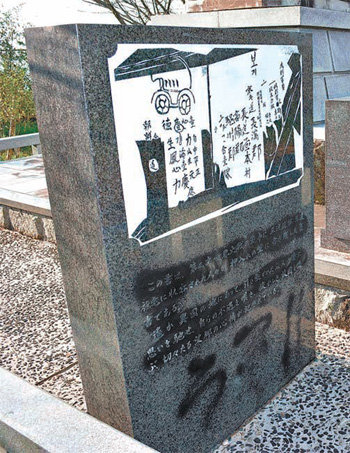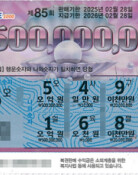Anti-Korea graffiti on monuments for Korean laborers forced by Japan
Anti-Korea graffiti on monuments for Korean laborers forced by Japan
Posted October. 26, 2015 11:04,

Some of the memorial monuments for Korean labor slaves who died while working in the Miike Coal Mine in Fukuoka Prefecture were `attacked` by a graffitist who is presumably a rightist Japanese.
The memorial monument, symbol of peace between Korea and Japan, was built in Omuta, Fukuoka in 1995 by the Japanese local government and a Japanese company that was responsible for the compulsory manpower draft. The Korean government found that 9,200 people were brought to the Miike Coal Mine and the Miike Port and 32 of them died during Japanese colonial era.
The Miike Coal Mine is registered as one of the 23 industrial revolution heritages of the Meiji era in UNESCO World Heritage in July, and Korea, in exchange for cooperating with the registration, has been requesting that the coerced labor should be included in the description.
According to the Korean Consulate General in Fukuoka on Sunday, an officer of the Korean Residents Union in Japan found that epitaphs on some monuments located at a part in Omuta were ruined by graffiti in black paint and reported it to the police immediately on Friday. The ruined part had a description of Korean workers` agonized writings, which had been found in a closet of the building where the labor slaves were kept. The graffiti included the word "liar (in Japanese)," written in big letters below this epitaph.
On another monument, a sticker of the Rising Sun flag, the symbol of Japanese militarism, was attached along with the writing, "Do not contaminate the mountain of Japan with these filthy stones." Another writing read, "(Korea) should make an apology to Lai Dai Han (children between Korean soldiers and Vietnamese women)."
"When I visited the monuments on Oct 15, there was no graffiti. I think somebody did it afterward," said Woo Pan-geun, the president of Jaeil Korea Omuta, a local civil group that initiated building the monuments, told the Dong-A Ilbo. "(Ruining the monuments) is a cowardly act. If someone has something to say, they should come out and have a talk face to face."
Woo pointed out that the Omuta City provided the land to build the monuments for free and that three companies affiliated to Mitsui who managed the coal mine paid for the building. "There are not many cases in Japan of a local government and companies cooperating with a civil organization to build monuments," Woo said.
Japan has recently experienced similar cases related to what is called the "Anti-Korea movement." In March, a 39-year-old man set fire to the Korean Culture Center in Tokyo with oil from lighters. In April, somebody uprooted a tree planted, by Korean and Japanese students as a token of friendship, in front of the monument for the Korean victims of the atom bomb in the Peace Memorial Park, Hiroshima.
On top of this, the Kyodo News reported on Sunday that Uemura Takashi, former journalist at the Asahi Newspaper known for first reporting a testimony in 1991 from the late Kim Hak-soon, a victim of military sexual slavery by Japan, could be fired from the university. Hokusei Gakuen University in Sapporo where he works as a part-time lecturer informed him that the university had to increase budget for his bodyguards and could discontinue his contract.
peacechaos@donga.com







